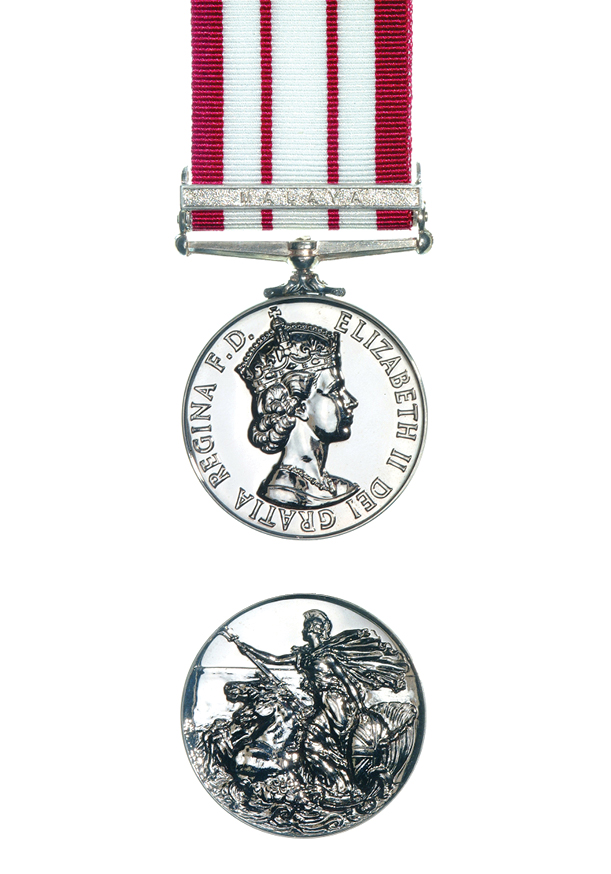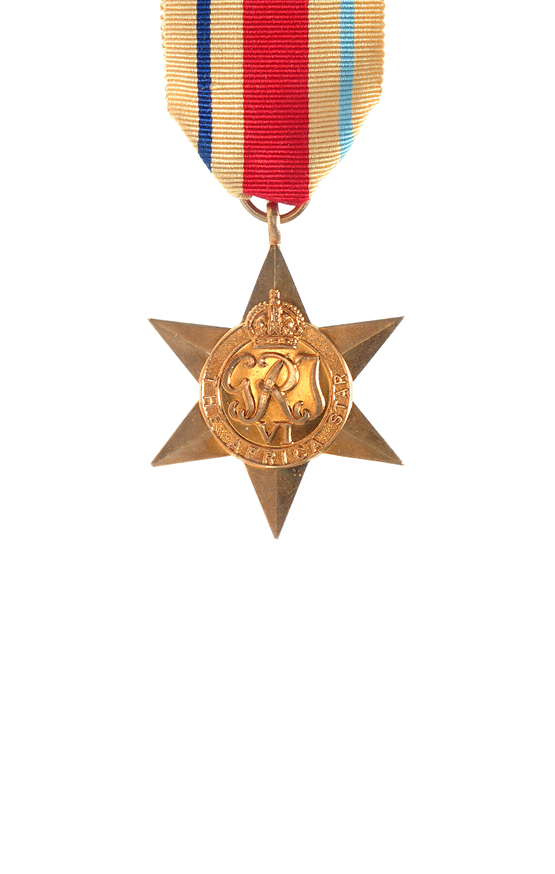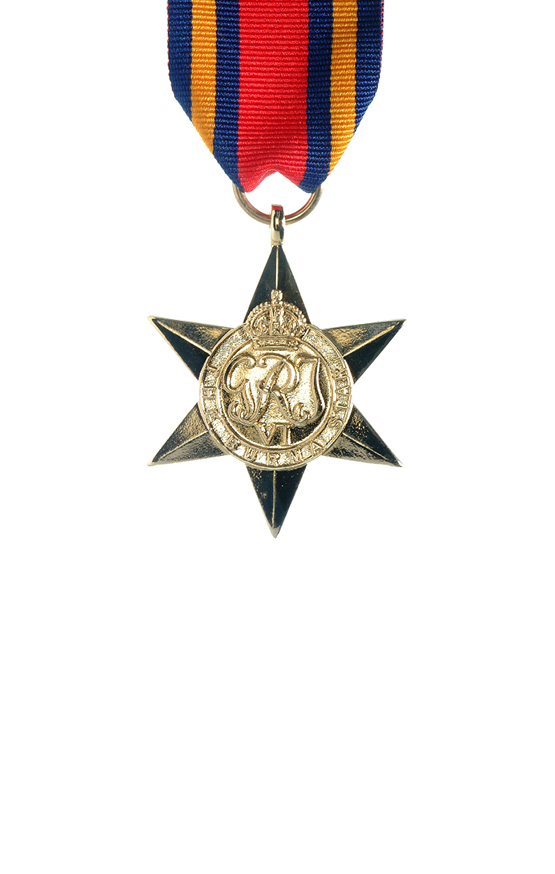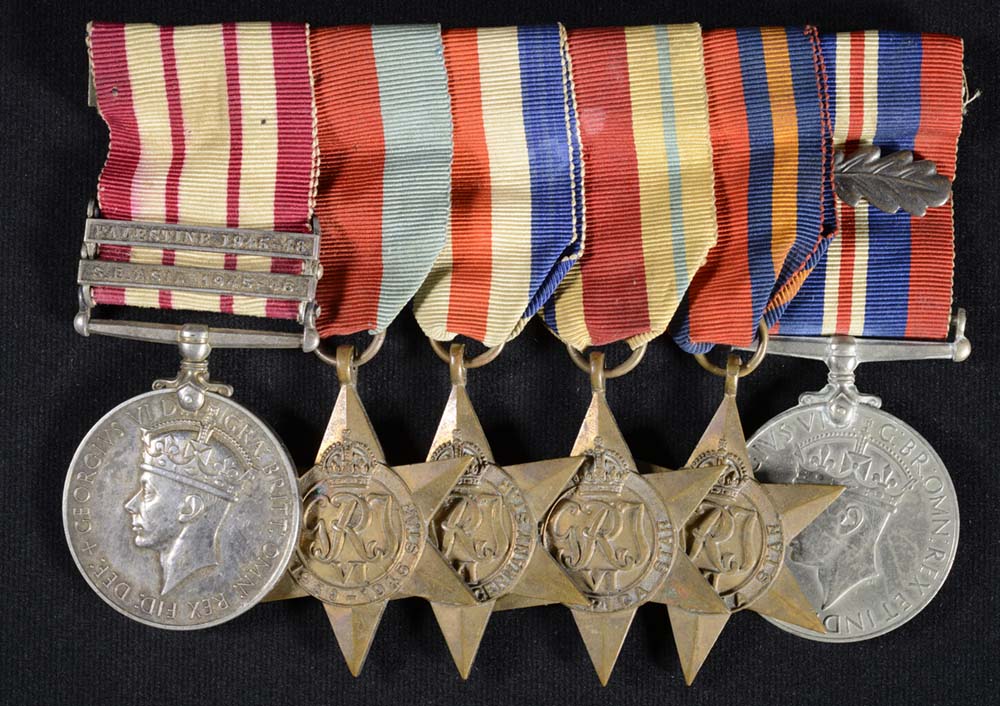

Display No. 2L
HEWITT, Gordon Clifford
Gordon Hewitt served in the Royal Navy in the Mediterranean, North Sea and Pacific during the Second World War. He was Mentioned in Despatches (MiD) for his naval service during the Second World War. After the war he served in naval operations in South East Asia and during the post-war Jewish insurgency in Mandatory Palestine.
Note: The medals here are displayed in the order in which they were donated to the museum, representing how they were worn by their recipients. In this case, Hewitt’s France and Germany Star and Naval General Service Medal are mounted incorrectly and should be placed after his Africa Star.
Awarded medal(s)
Medal Description [Left to Right]:
The Naval General Service Medal 1915-1962

The Naval General Service Medal (NGSM) 1915-1962, was instituted in 1915 to recognise service in minor naval operations for which no separate medal was intended. They were always issued with a clasp for the specific area of operation. A total of seventeen clasps were awarded. Examples in our collection include the ‘Persian Gulf 1909-14’ clasp for operations against gun-runners; the ‘Palestine 1936-39’ and ‘Palestine 1945-48’ clasps which were issued for service in the pre-war Arab uprising and post-war Jewish insurgency; the ‘Minesweeping 1945-51’ clasp which was awarded for six months minesweeping service afloat; the ‘Malaya’ clasp recognising the service of naval personnel, including the Royal New Zealand Navy, during the Malayan Emergency of 1948-1960; and the ‘Yangtze 1949’ clasp for those on HMS Amethyst and other vessels attacked by Communist Chinese forces.
The 1939-1945 Star

The 1939-45 Star is the first in a series of eight campaign stars instituted in 1945 to recognise service in World War Two. The ribbon has three equal vertical stripes of dark blue, red and light blue. The dark blue stripe symbolises the service of the Navy and the Merchant Navy, the red stripe symbolises the service of the Army, and the light blue stripe symbolises the service of the Air Force. The equal width bands represent the equal contributions of the three service arms towards victory. The ribbon was devised by King George VI. Two clasps could be awarded with this medal: ‘Battle of Britain’ and ‘Bomber Command’. Only aircrew would qualify for these clasps although a small number of Fleet Air Arm naval pilots flew for the air force and would be eligible for the ‘Battle of Britain’ clasp.
The France and Germany Star

The France and Germany Star was awarded for service in the Second World War in France, Belgium, the Netherlands, Germany and adjacent sea areas, between 6 June 1944 and 8 May 1945. An ‘Atlantic’ clasp could be awarded with this medal. Personnel who qualified for both the France and Germany and the Atlantic Stars were awarded the first star but only a clasp in respect of the second. The ribbon uses the colours of the Union Jack; red, white and blue, which are also the national colours of France and The Netherlands.
The Africa Star

The Africa Star was awarded in the Second World War for service in North Africa between 10 June 1940 and 12 May 1943. The ribbon is pale buff in colour, with a central vertical red stripe, and narrower stripes, one dark blue and the other light blue. The pale buff background symbolises the desert, the central red stripe symbolises the Army, the dark blue stripe symbolises the Navy and Merchant Navy, and the light blue stripe symbolises the Air Force. Three clasps could be awarded with this medal: ‘North Africa 1942-43’, ‘8th Army’, and ‘1st Army’. Naval personnel could only qualify for the ‘North Africa 1942-43’ clasp – for in shore service.
The Burma Star

The Burma Star was awarded for service in the Second World War in the Burma campaign, from 11 December 1941 to 2 September 1945. The centre of the ribbon is red (representing the Commonwealth forces) with outer stripes of dark blue (representing the British forces). The dark blue bands each have at their centres a stripe of bright orange (symbolising the sun). A ‘Pacific’ clasp could be awarded with this medal. Personnel qualifying for both the Pacific and Burma Stars were awarded the first star but only a clasp in respect of the second.
The War Medal 1939-1945

The War Medal 1939-45 was awarded across the British Commonwealth to all full-time members of the Armed Forces in the Second World War for 28 days service between 3 September 1939 and 2 September 1945, irrespective of where they were serving. The ribbon is the red, white, and blue of the (British) Union Flag. There is a narrow central red stripe with a narrow white stripe on either side. There are broad red stripes at either edge, the two intervening stripes being blue.
A bronze oak leaf on the medal ribbon denotes that the recipient was Mentioned in Despatches. To be Mentioned in Despatches a member of the armed forces had their name mentioned in an official report, written by a superior officer, and sent to a higher command. The report would describe the individual’s gallant or meritorious action in the face of the enemy.

